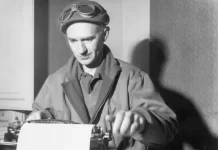There are lots of local historians who love our Bayshore towns and have authored books about so many of the people places and things we all love. Randy Gabrielan is one of that group, and probably the most prolific, judging from the dozens of books on local history he has written or shown in photographs. He’s been the Monmouth County historian and continues to serve on the Monmouth County Historical Commission.
But way back in 2007, Randy, who used to be an insurance broker, wrote and pictured a book about his own native city, Jersey City. Titled “Jersey City, A Monumental History,” the book is chock full of photos of some of the magnificent architecture that made Jersey City a standout community for decades. He’s divided the book into chapters highlighting each of the individual communities or sections of the city, including Journal Square and The Heights, Greenville, the waterfront, downtown and Communipaw.
Although mostly an illustrated book, Gabrielan doesn’t mince words when he addresses some of the problems the city faced during growth, blaming it on the state’s poor mechanism for forming municipalities. He also talks about some of the other growing pains Jersey City has suffered, as well as the impact of the railroad as it tunneled through Bergen Hill, the oldest settlement from which the whole city has grown.
He writes about how street names have changed, and whether the Statue of Liberty is legally in New Jersey or New York. He’s got some photos of Snyder High School , many of whose graduates now live in the Bayshore, and he included a great photo of the Romanesque Revival building of the 19th century that was the Jersey City Police headquarters and only lasted about half a century.
The book is also full of photos of churches in Jersey City, and gives a striking picture of how many there are, or were, and how many denominations they represent. There are catholic churches in Jersey City now on the National Registry, and the Jersey City Ukrainian Catholic Church of St.s Peter and Paul. That was first founded in 1887, the second Ukrainian catholic church in the United States and since demolished after its purchase by Colgate. But another building incorporating traditional Ukrainian motifs including five onion-shaped domes, replaced it in the late 20th century, when it was declared a tribute to all of the churches in Ukraine.
The many catholic churches in the city met the spiritual needs of the many immigrant catholic who worked the factories there.
The Dutch Reformed Church built in 1857 in Gothic Revival style, the Episcopalian Church of St. Matthew was built in 1881 and later became a catholic church to meet the needs of the growing Irish catholic community who worked in the local factories. St. Bridget’s rose from a small fame structure on Brunswick and Mercer streets to become another Gothic style church on Montgomery st, designed by Patrick Keeley in 1886. This church underwent preservation in 2006 after it was consolidated into the Parish of the Resurrection.
The Centenary Methodist Episcopal Church on Pavonia Avenue was built in 1882, and in the 20th century became home to the Central Missionary Baptist Church. And the list goes on.
The book was published by Schiffer Books, is well researched and certainly draws one’s attention to the many reasons Jersey City natives are so proud of their birth place, regardless of where they live today.
For more information on this, or any of Randy’s books, message Randall Gabrielan on Facebook.



